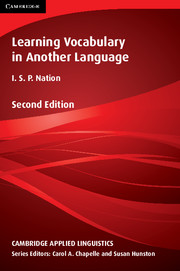Book contents
- Frontmatter
- Contents
- Series editors' preface
- Acknowledgements
- Introduction
- 1 The goals of vocabulary learning
- 2 Knowing a word
- 3 Teaching and explaining vocabulary
- 4 Vocabulary and listening and speaking
- 5 Vocabulary and reading and writing
- 6 Specialised uses of vocabulary
- 7 Vocabulary-learning strategies
- 8 Learning words from context
- 9 Word parts
- 10 Using dictionaries
- 11 Deliberate learning from word cards
- 12 Finding and learning multiword units
- 13 Testing vocabulary knowledge and use
- 14 Designing the vocabulary component of a language course
- Appendices
- Subject index
- Author index
3 - Teaching and explaining vocabulary
Published online by Cambridge University Press: 15 February 2018
- Frontmatter
- Contents
- Series editors' preface
- Acknowledgements
- Introduction
- 1 The goals of vocabulary learning
- 2 Knowing a word
- 3 Teaching and explaining vocabulary
- 4 Vocabulary and listening and speaking
- 5 Vocabulary and reading and writing
- 6 Specialised uses of vocabulary
- 7 Vocabulary-learning strategies
- 8 Learning words from context
- 9 Word parts
- 10 Using dictionaries
- 11 Deliberate learning from word cards
- 12 Finding and learning multiword units
- 13 Testing vocabulary knowledge and use
- 14 Designing the vocabulary component of a language course
- Appendices
- Subject index
- Author index
Summary
The main message of this chapter is that vocabulary teaching has only a limited role to play in the learning of vocabulary (about one-quarter of one of the four strands of a course), and teachers need to be careful not to overplay this role at the expense of the time available for the deliberate and incidental learning of vocabulary.
What is involved in vocabulary teaching and what role should teaching play?
Many first language researchers question the value of spending teaching time on particular words, especially using rich instruction. The arguments used against the direct teaching of vocabulary for first language learners include the following:
There are too many words to teach. Research on the vocabulary size of native speakers shows that, even by the most conservative estimates (D'Anna et al., 1991; Nation, 1993), native speakers know tens of thousands of word families. Direct teaching could only have a very trivial impact on such knowledge.
There is a lot to learn about each word (Nagy, 1997). Chapter 2 of this book outlined the various aspects of what is involved in knowing a word. Nagy challenges the idea of a word family, showing that for many complex and compound forms of words there is substantial extra learning required, and this increases the number of words to be learned.
To have an immediate effect on vocabulary knowledge, substantial time has to be spent on teaching each word.
[…]
- Type
- Chapter
- Information
- Learning Vocabulary in Another Language , pp. 92 - 160Publisher: Cambridge University PressPrint publication year: 2013



